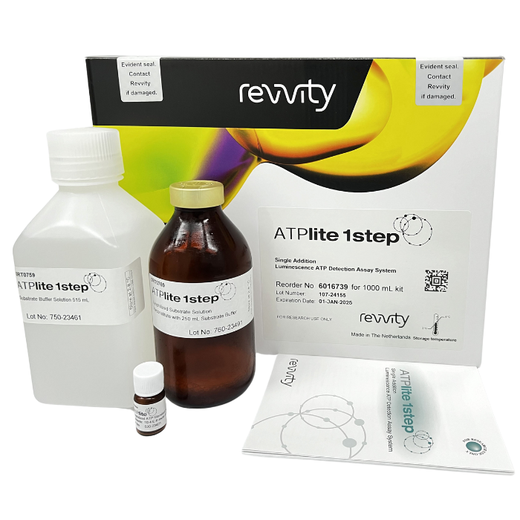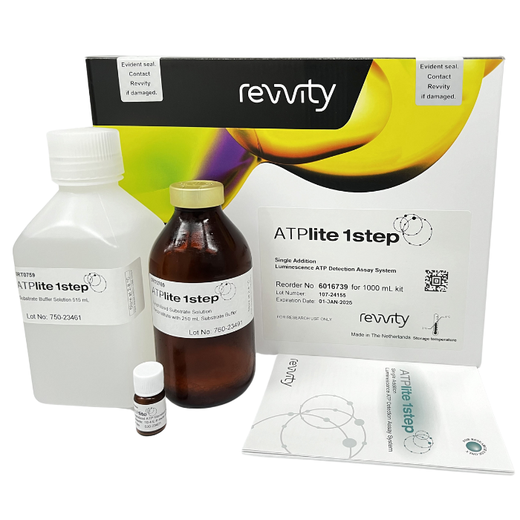
ATPlite 1step Luminescence Assay System, 100 mL ATP Assay Kit

ATPlite 1step Luminescence Assay System, 100 mL ATP Assay Kit




ATP luminescence assay for quantitative evaluation of proliferation and cytotoxicity of cultured mammalian cells. The 1step luciferase ATP assay format only requires one addition step, and can be used for continuous processing.
For research use only. Not for use in diagnostic procedures. All products to be used in accordance with applicable laws and regulations including without limitation, consumption and disposal requirements under European REACH regulations (EC 1907/2006).
| Feature | Specification |
|---|---|
| Application | Cell Viability |
| Assay Points | 1000 |
ATP luminescence assay for quantitative evaluation of proliferation and cytotoxicity of cultured mammalian cells. The 1step luciferase ATP assay format only requires one addition step, and can be used for continuous processing.
For research use only. Not for use in diagnostic procedures. All products to be used in accordance with applicable laws and regulations including without limitation, consumption and disposal requirements under European REACH regulations (EC 1907/2006).


ATPlite 1step Luminescence Assay System, 100 mL ATP Assay Kit


ATPlite 1step Luminescence Assay System, 100 mL ATP Assay Kit


Product information
Overview
ATP is a marker for cell viability due to its presence in all metabolically active cells. ATP concentration declines rapidly when cells undergo necrosis or apoptosis, and so monitoring ATP is a good indicator of cytotoxic, cytostatic and proliferation effects.
Our ATPlite 1step ATP luminescence assays use patented technologies to measure cell proliferation and cytotoxicity in mammalian cells based on the production of light caused by the reaction of ATP with added luciferase and D-luciferin.
Features and benefits:
- Simple and reproducible: only one reagent addition step, no separation steps
- Suitable for both 96- and 384-well microplates
- Linear correlation between cell number and luminescent signal: up to 50,000 cells per well for 96-well microplates and 12,500 cells per well for 384-well microplates
- Designed for continuous process systems: luminescence should be measured between 0 and 30 minutes after reagent addition and plate shaking
- Homogeneous: no cell harvesting or centrifugation required
- High sensitivity: able to detect down on one cell per well
- Reduced Phenol Red dependency
- High light-output: assay can be used with less sensitive luminescence readers such as multi-label readers
- Fast: no luminescence signal stabilization time required
An alternative format of this assay is also available. The ATPlite assay has separate cell lysis and luminescent signal generation steps. This allows for a more stable signal, with half-life of at least 4 hours.
Specifications
| Application |
Cell Viability
|
|---|---|
| Assay Points |
1000
|
| Automation Compatible |
Yes
|
| Brand |
ATPlite 1step
|
| Cellular or Signaling Pathway |
Autophagy
Cell Death
Cell Growth
Cytotoxicity
Necrosis
|
| Cellular Process |
Autophagy
Cell Death
Cell Growth
Cytotoxicity
Necrosis
|
| Detection Modality |
Luminescence
|
| Format |
Microplates
|
| Protocol |
1-step
|
| Signal Halflife |
0.5 hour
|
| Shipping Conditions |
Shipped Ambient
|
| Unit Size |
100 mL
|
Citations
Resources
Are you looking for resources, click on the resource type to explore further.
Breast cancer tumors can adapt to immune cell infiltration by responding to the increased concentration of interferon gamma (IFN-ɣ...
This application note demonstrates how compound’s mechanism of action and potential cytotoxic effects can be deciphered thanks to...


How can we help you?
We are here to answer your questions.






























